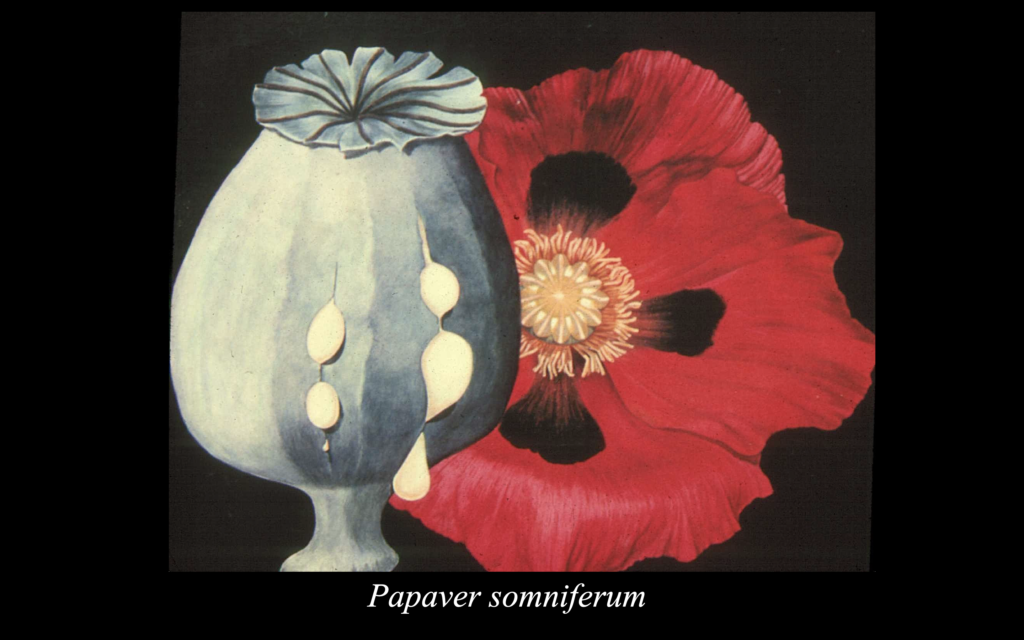
Opium poppy (Papaver somniferum) image in public domain.
By Patrick Hunt –
Any history of the opium poppy, in this case Papaver somniferum or the “sleep-bringing” poppy, must be replete with its known medical use and perhaps equally its less scientific lore. Why it has been known as the “sacred poppy” as a signifier of its religious utility is fascinating and actually logical as well. Its human usage appears to span many thousands of years, perhaps at least 8,000 years or more into the Early Neolithic, since archaeological traces do not tell us how long it has been used but merely record the oldest known contexts that have survived. This very brief survey mostly deals with Aegean contexts with clear visual details.
Analyses across Europe and the Near East suggest that the opium poppy is one of the earliest domesticated plants, a cultivar deliberately hybridized from wild poppies of the Papaver genus, possibly since 5900 BCE (7900 BP) in Europe alone as known from 50 Neolithic sites. [1] At least one poppy seed has also been found associated with the Alpine frozen mummy, Ötzi the Iceman, ca. 3300 BCE (5300 BP) from the Ötztal Alps between current Tyrolean Italy and Austria as part of his apparent medical kit of multiple effective pain mitigations mainly from plants with analgesic properties. [2] This long history indeed evidences some working knowledge of the opium poppy’s pain-reducing benefits. History of the opium poppy has also been fraught with political, economical and sociological trends and patterns as well s religious associations for millennia as control of such resources has been a struggle for power and revenue.[3]
Although not the focus here – which is mostly Aegean – the opium poppy’s Near Eastern and Anatolian history could be longer by several millennia, since it appears to have originated somewhere around the Eastern Mediterranean [4] or Mesopotamia and Anatolia (mostly modern Turkey), possibly by at least another millennium or more prior to its European Neolithic use – although ambiguous and complicated – and then spread westward before 7000 BCE or eastward as known from poppy finds in the Levant at Atlit-Yam (ca. 6700-6400 BP) and Kortik Type in southern Anatolia (even possibly before 9250 BP) [5]
Sumerian cuneiform has also apparently preserved reference to opium as hul gil or “joy plant” from ca. 3500 BCE (~5500 BP) if identification is secure from a Nippur tablet [6]; from Mesopotamia it passed to Egypt and the Levant and ultimately to – or back to – the Mediterranean and Europe. Another Sumerian tablet from 2100 BCE records what is “considered the world’s oldest medical prescription” with opium poppy as the plant medicine. [7] Interestingly, evidence in Ancient Egypt appears only late, from New Kingdom in the 18th Dynasty, ca. 1550 BCE. [8] New Kingdom papyrological Egyptian medical texts such as Ebers, Smith, Hearst and others mention poppy or poppy seeds (possibly spn or shepen) as analgesic or sleep-inducing for therapeutic relief. [9] Egyptian New Kingdom jewelry also shows numerous popular necklaces with carnelian poppy heads as amulets (see image below), sometimes interspersed with faience or other materials depicting Taweret hippo birthing-goddess amulets, suggesting dual religious and spiritual associations with easing childbirth pain.
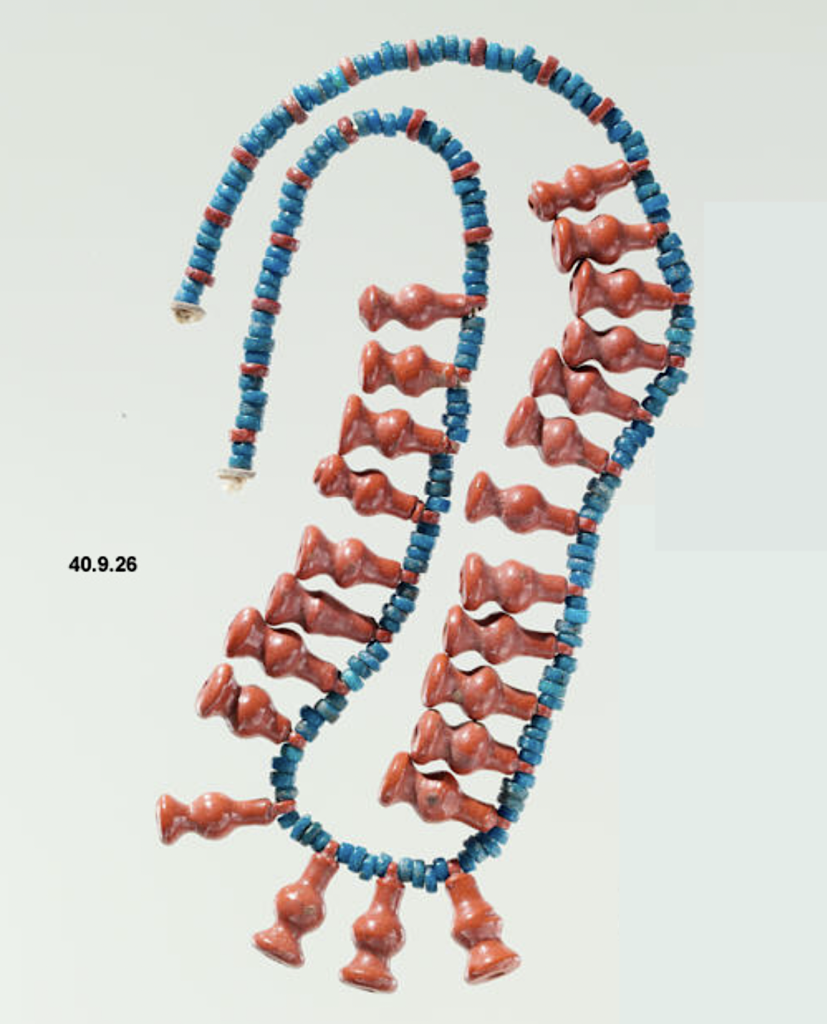
Egyptian New Kingdom Carnelian Poppyhead and Faience Necklace, ca 1550-1295 BCE, Met. Mus. NY Inv. / Acc. #40-9-26
Regarding sacred poppy contexts, the Bronze Age Aegean has a fascinating history with opium in religious contexts from the Late Minoan Period (LM III ca. 1400-1100 BCE) as well as in the Mycenaean Period in the Late Bronze Age, also ca. 15th c. BCE. Notable in the Herakleion Archaeological Museum in Crete, there is a ceramic “goddess” figure from Gazi, Crete, with upraised hands, where a consensus of scholarship agrees that her head is crowned with poppy heads vertically slit to extract opium. The museum inventory database also draws the same conclusion that she can be called a “Poppy Goddess”. [10] This is confirmed elsewhere in Higggins’ Minoan and Mycenaean Art: “…three poppyhead on her crown. (Illustr. 152) As the poppyheads have apparently been slashed in the same way they are cut today to extract opium, it has been suggested that she is a [healing] goddess of drug-induced peace and forgetfulness.” [11]
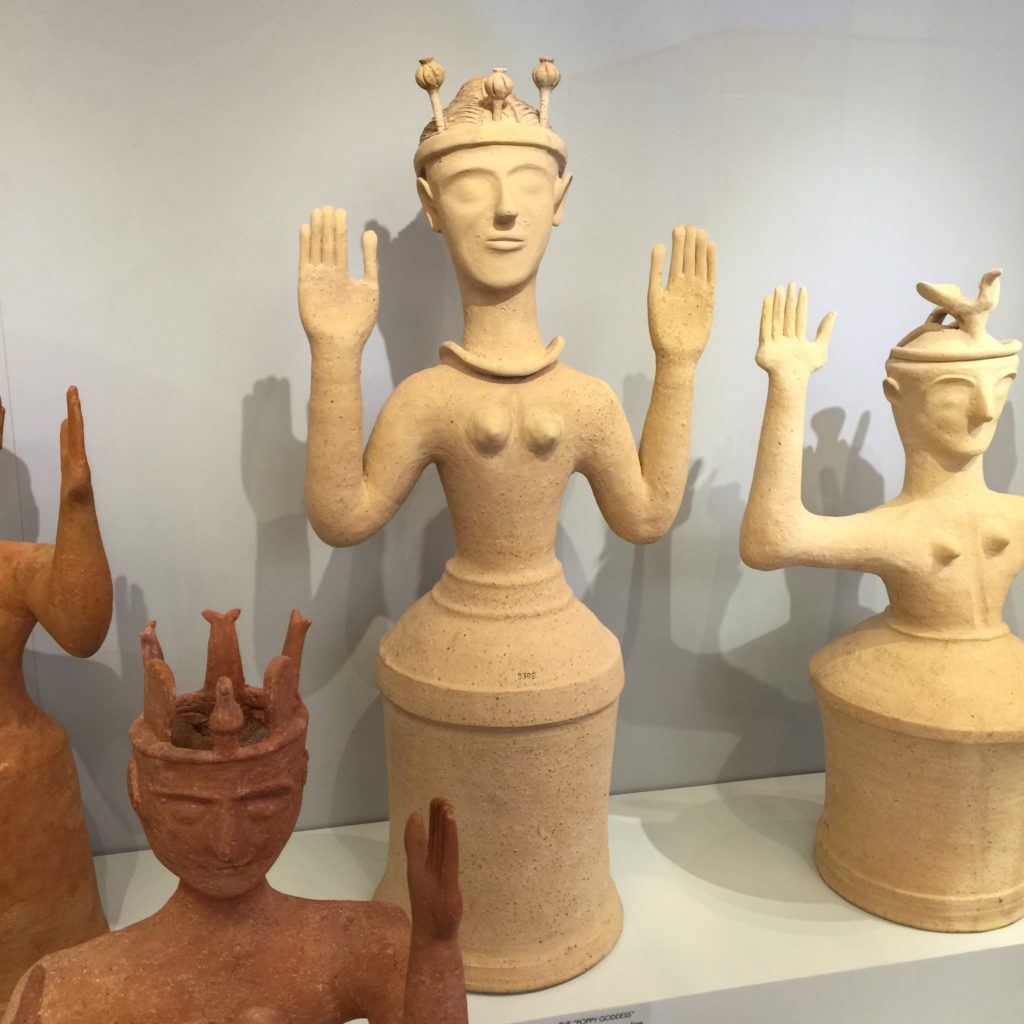
Cretan Gazi Ceramic “Poppy Goddess”, ca. 1400-1100 BCE, Heraklion Archaeology Museum (Photo P. Hunt, 2016)
Furthermore, in the same tome, Higgins discusses a gold ring find from Mycenae of probable Cretan origin: “A ring from Mycenae [in the National Archaeology Museum, Athens] of approximately the same date [1425-1400 BCE] shows another religious scene. (Illustr. 240) The subject matter and the style would suggest that it is Cretan work; if not it is certainly Cretan-inspired. A goddess sits under a sacred tree, holding three poppies…In front of her are three women, probably worshippers, who carry lilies…” [12] Also note medical scholars have discussed opium use in Minoan culture from these and other artifacts, including ribbed lekythi ceramic vessels with poppy calyx shapes, among other evidences that “reveal the sacred nature attributed to the [opium] plant by the Minoans”. [13]
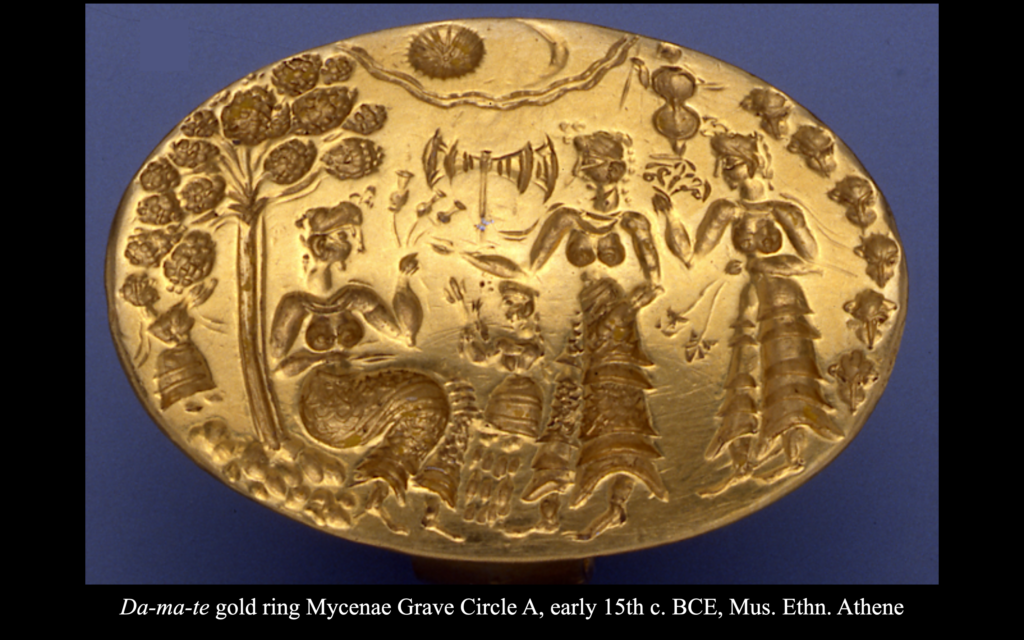
Da-ma-te ? Minoan style Gold Ring from Mycenae, ca. 15th c. BCE (Image in public domain)
Back to the fascinating likely Minoan gold ring from Mycenae, the seated goddess under the tree has often been identified albeit speculatively with the Mother Goddess Da-ma-te in Linear B Proto-Greek, not the least reason being that a small girl approaches her first before the other two larger females with what appear to be a sprig of wheat or grain. The girl offering grain has frequently been suggested as Persephone, the daughter of Demeter, the later Greek rendering of the Proto-Greek Linear B Da-ma-te. These two mother-daughter goddesses are also later amply featured in the Homeric Hymn to Demeter (ca. 7th c. BCE) and many other texts including the seminal texts of Mylonas about Eleusis and its ancient mysteries. [14]
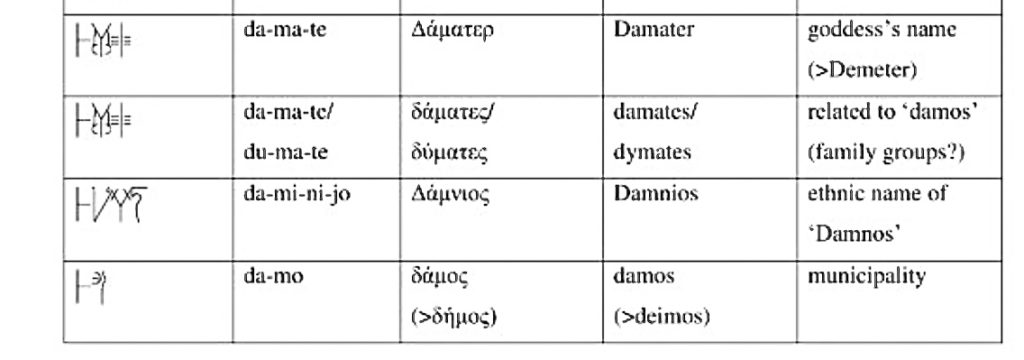
Note the Linear B Lexicon excerpt (Chris Tselentis via Internet Archive) above for da-ma-te, with the Linear B tri-syllabic script compound on the left and later renderings moving left to right in the tables, where scholars posit this as a possibly 16th-13th c. BCE entry from extant archaeological tablets or other epigraphy, although not all agree whether it might suffice as a reading for the goddess Demeter. Another difficulty with the above gold ring from Mycenae is that it has no text whatsoever and whether or not da-ma-te with this possible meaning can even be found earlier in Cretan or Minoan Linear A is also debated. [15] Given the range of highly arguable interpretations of da-ma-te, perhaps it is more productive to look later to Eleusis.
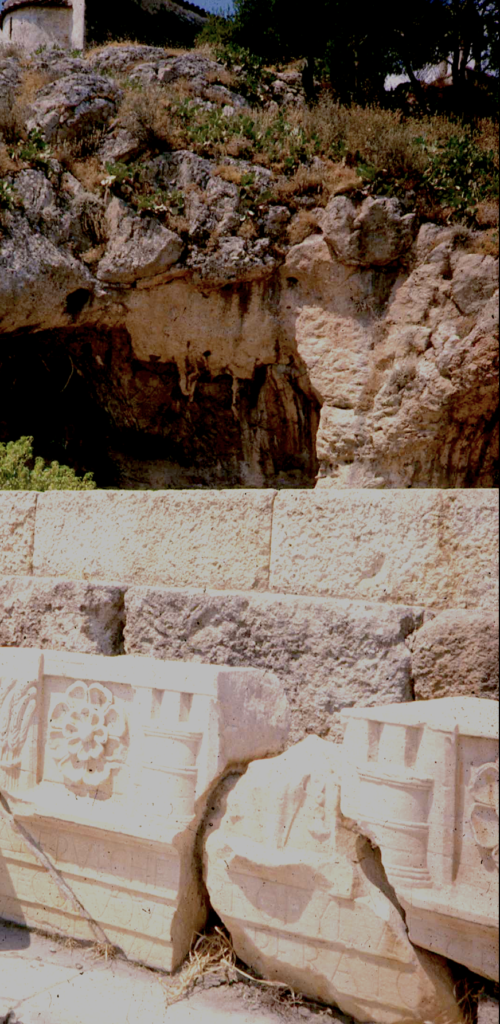
Hadrianic Telesterion relief segment in front of Ploutoneion Cave, Eleusis (photo P. Hunt 1984)
Corroboration of this dual identification with Demeter and Persephone may come later from Classical Eleusis itself and its surviving Telesterion Doric frieze from the Hadrianic Period, 2nd c. CE. Not in its original context, the marble frieze is positioned in front of the Ploutoneion Cave below the Bronze Age acropolis of Eleusis, the putative cave where myth has Persephone emerge from the Underworld.
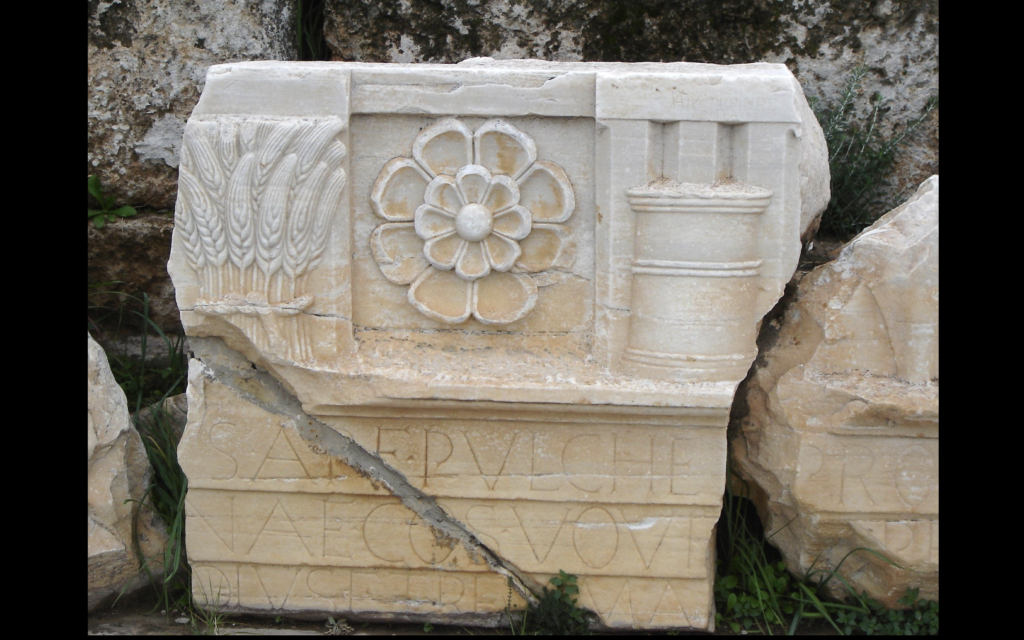
Hadrianic Telesterion relief segment, Eleusis, enlarged with triglyphs and metope: grain sheaf, “poppy”, kiste (Photo in public domain)
The Doric Frieze depicts triglyphs with superimposed sheaves of grain and the sacred kiste vessel of the Mysteries and the metope with a flower that is usually interpreted as a poppy. At the inner core of the much-conflated Telesterion sacred initiation ceremony hall was the Bronze Age Anaktoron, by this time underground and built over by many successive centuries, where a person modeling Persephone may have emerged in the divinely-connected initiation ritual, although this cannot be easily confirmed. Nonetheless, the attributes of Demeter are dually grain and poppy, the latter because she was also the Greek goddess of divine pain relief.
While this brief survey emphasizing Aegean contexts has some speculative elements in “connecting dots” or drawing connections (not all of them necessarily original to this author) and the debatable interpretations, it nonetheless appears consistent across time and culture that pain relief was so often believed to be a divine gift from the gods to mortals for easing their lives of pain in the ancient world. Thus, it is easily understandable that in the ancient Aegean, the goddess Demeter was the personal agency by which this divine gift of opium was offered, also making it illogical to divest the poppy of its sacred context, especially since pain relief was considered one of the greatest divine boons.
Notes:
[1] Salavert, Zazzo, A., Martin, L. et al. “Direct Dating Reveals the Early History of the Opium Poppy in Western Europe.” Nature: Scientific Reports 10 20263 (2020) (https://doi.org/10.1038/s41598-020-76924-3). Also see Salavert, A., Martin, L., Antolín, F. & Zazzo, A. “The opium poppy in Europe: Exploring its origin and dispersal during the Neolithic.” Antiquity 92 (364) 2018 (https://doi.org/10.15184/aqy.2018.154).
[2] Heiss, A. G. and Oeggl, K. D. “The plant macro-remains from the Iceman site (Tisenjoch, Italian-Austrian border, eastern Alps): New results on the glacier mummy’s environment.” Vegetation History and Archaeobotany 18 (2009) 23-35 (https://link.springer.com/article/10.1007/s00334-007-0140-8)
[3] Chouvy, P.-A. Opium: Uncovering the Politics of the Poppy. Cambridge, MA: Harvard University Press, 2010.
[4] Linares, V.; Jakoel, E; Be’eri, R. et al. “Opium Trade and Use during the Late Bronze Age: Organic Residue Analysis of Ceramic Vessels from the Burials of Tel Yehuid, Israel.” Archaeometry (July 2022) 1-18 (https://doi.org/10.1111/arcm.12806). The article cites ambiguity in determining origin but does suggest that opium diffusion into the Aegean arrived via Asia Minor.
[5] Salavert et al., 2020, Figure 1, Diagram A1-B1.
[6] Krikorian, A. D. “Were the Opium Poppy and Opium Known in the Ancient Near East?” Journal of the History of Biology 8.1 (1975) 95-114, esp. 98.
[7] Norn, Svend; Kruse, Paul and Kruse, Edith. “History of Opium Poppy and Morphine.” Dan Medicinhistorisk Årbog. 33 [Danish Medicine History Yearbook (2005) 171-84 (https://pubmed.ncbi.nlm.nih.gov/17152761/); DEA Museum, 2021 (https://museum.dea.gov/exhibits/online-exhibits/cannabis-coca-and-poppy-natures-addictive-plants/opium-poppy#:~:text=The%20earliest%20reference%20to%20opium,it%20on%20to%20the%20Egyptians.).
[8] Behn, C. P. “The Use of Opium in the Bronze Age in the Eastern Mediterranean. Folia Philologica 109.4 (1986) 193-7, esp. 194 ff.; C. Reeves. Egyptian Medicine. Shire Egyptology Series 15. 1992, 58-9; John F. Nunn. Ancient Egyptian Medicine. Norman: University of Oklahoma Press, 2002 ed., 153-6.
[9] Metwaly, A. M.; Ghoneim, M.. M. Eissa, I. H. et al. “Traditional Ancient Egyptian Medicine: A Review.” Saudi Journal of Biological Science 28.10 (2021 Elsevier) 5823-32 [via ncbi.nlm.nih.gov](https://www.sciencedirect.com/science/article/pii/S1319562X21005027?via%3Dihub ).
[10] Herakleion Archaeology Museum database (Excel spread sheet) Inv. # Pi9305 / photo A758, updated 2024.
[11] Reginald Higgins. Minoan and Mycenaean Art. London: Thames and Hudson, 1997, p. 127, fig. 152.
[12] ibid., 186-7.
[13] Askitopoulou, H. Ramoutsaki, I.; Konsolaki, E. “Archaeological Evidence on the Use of Opium in the Minoan World.” International Congress Series (Elsevier) 1242 (3), Dec. 2002, 23-29. This publication also depicts multiple poppy calyx-shaped lekythi ceramic vessels, presumably originally containing opium products, 4, Fig. 1 A-B-C.
[14] Mylonas, George. Eleusis and the Eleusinian Mysteries. Princeton University Press, 1969. Mylonas mentions poppies as a visual symbol of the cult along with wheat and on the Eleusis frieze (p. 159) and also mentions the Mycenae gold ring but does not necessarily agree with the Demeter-Persephone identification (pp. 52-3).
[15] Linear B Lexicon, Chris Tselentis, Internet Archive 2017 (https://archive.org/details/LinearBLexicon) or (https://www.palaeolexicon.com or https://archive.org). Also see the back-and-forth debate about da-ma-te in Andreas Willi. “Demeter, Gê, and the Indo-European word(s) for ‘earth.’ ” Historische Sprachforschung Bd. 120 (2007) 169-94; Duhoux, Y. and A. Morpurgo-Davis, eds. Companion to Linear B, vol. 2. Leuven: Peeters (2014) 26; M. Ventris, J.Chadwick, A. Wace. Documents in Mycenaean Greek: Three Hundred Selected Tablets from Knossos, Pylos, Mycenae…, Cambridge University Press, 2015, 242; B. Dietrich. The Origins of the Greek Religion. Bristol Phoenix Press, 2004, 172. Also note Jane Harrison suggested Demeter originally meant “Grain Mother” rather than “Earth Mother” in Jane Ellen Harrison. Myths of Greece and Rome, Doubleday-Doran, 1928, 63-4.